The late 19th and early 20th centuries marked a “golden era” of
manufacturing in the developed world that contributed to the
largest increases in living standards in recorded history. This
was initially fuelled by huge productivity improvements in
agricultural production that allowed for significant migration
of labour into the manufacturing sector. Manufacturing itself
had already been transformed by the industrial revolution that
began in the UK a century before. It was further transformed by
mechanised mass production into a highly productive sector that
offered rising wages with which to purchase the increasing
variety of manufactured goods on offer. The result was an
increase in manufacturing’s share of total output across the
developed world through the first half of the 20th century.
As a result of manufacturing breakthroughs, the prices of a
wide variety of goods have fallen, greatly benefiting consumers
Since then, the economic footprint of manufacturing has shrunk
in relative terms in most of the rich nations. In some cases,
the changes have been dramatic. At the same time, productivity
gains within manufacturing have outpaced the economy as a
whole, lowering the cost of manufactured goods and allowing
labour to migrate to the service sector. At this stage of
development, the share of manufacturing within an economy
typically declines as growth in the service sector outpaces
manufacturing, which may or may not be contracting itself.
So there is a sense in which manufacturing is a victim of its
own success. The cost of manufactured goods relative to
services has plummeted in the past 50 years, making an
increasing variety of products more affordable and freeing
households’ income for spending in other areas. This has led to
saturation in some developed markets. In much the same way that
agriculture can now provide for global food requirements with
less than 5 per cent of global economic activity, manufacturing
can satisfy global demand for goods despite accounting for less
than 20 per cent of global output.
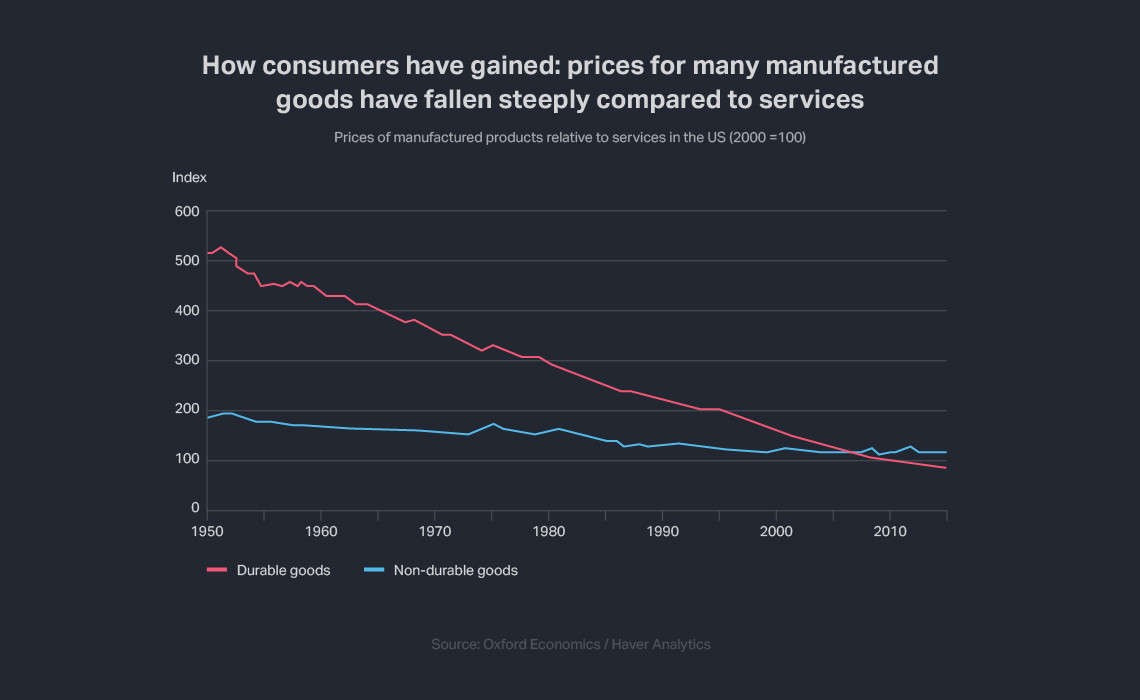
Despite its diminished footprint, manufacturing in the
developed world continues to flourish mainly because these
countries have the skills and technical know-how to support
sophisticated high-value engineered products such as aerospace
equipment and precision instruments. The growth of
manufacturing in the emerging world has been driven much more
by relatively unsophisticated manufacturing, in areas such as
basic clothing and building materials. In developed
countries – where workers generally have greater technical
expertise – low-skill parts of manufacturing such as these have
become less important. Of course, as countries develop further,
they begin to move up the value chain; China is perhaps the
best example, having become an important producer of motor
vehicles and with aspirations to move into aerospace.
25 years of change – and the UK slips
The past quarter century can be divided into two periods.
During the 1990s, the developed world enjoyed the strongest and
longest economic expansion for decades. By the middle of the
decade annual growth in the US’s total output was well above 4
per cent, while in Western Europe it was almost 3 per cent.
While global trade was strong, manufacturing supply
chains were still largely regional, with most activity
occurring within the developed world. So even though the
developed world’s share of global manufacturing slipped during
this period, it remained at a commanding 70 per cent by the end
of the decade.
This changed dramatically upon the accession of China into the
World Trade Organisation at the end of 2001. Since then, its
share of global manufacturing has more than doubled from 9 per
cent to 23 per cent and it has become a central player across a
broad spectrum of sectors. This has had ripple effects across
other South-East Asian countries such as Indonesia, Thailand
and Vietnam. As a result, emerging economies became more fully
integrated into manufacturing value chains. This has
essentially equalised the global manufacturing share of the
developed and emerging world.
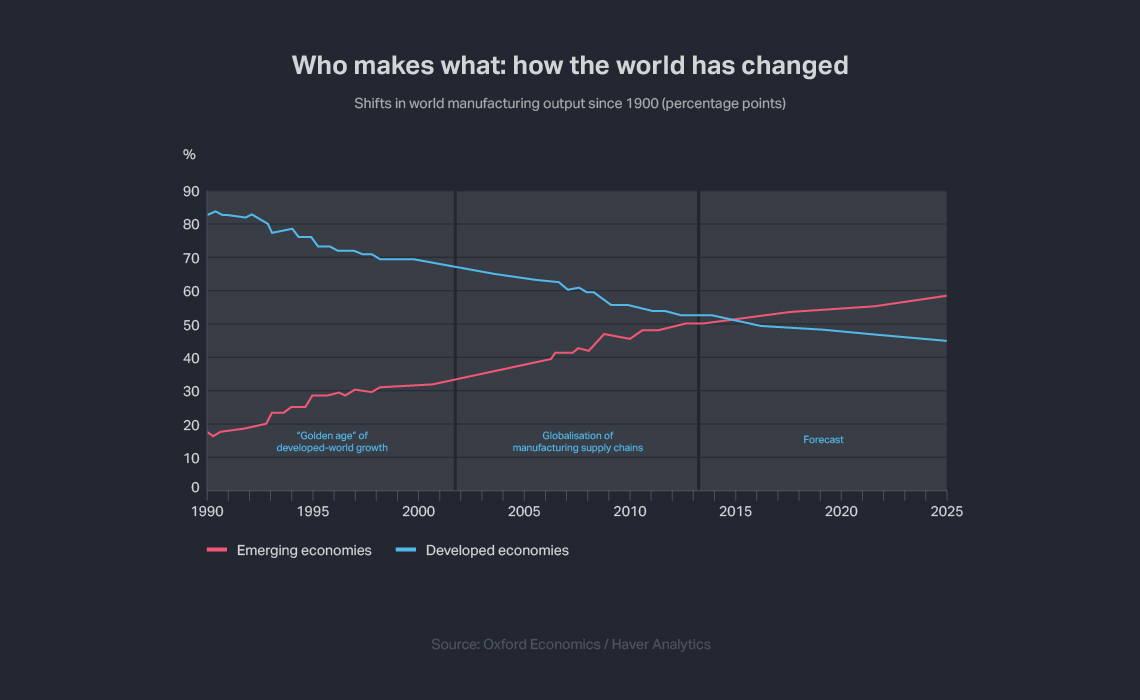
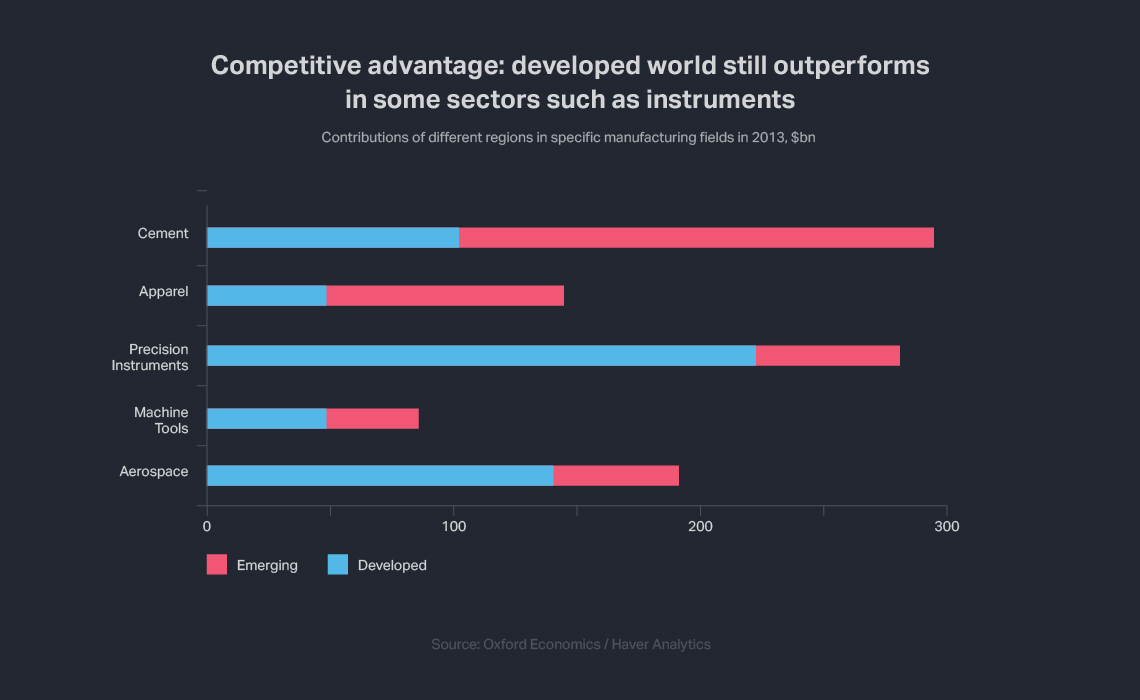
There are contrasts within the developed world in terms of the
evolution of the manufacturing footprint over the past 25
years. Perhaps the most surprising observation is that,
allowing for ups and downs related to the business cycle, in
inflation-adjusted terms manufacturing has been remarkably
stable across many countries. This provides welcome evidence
that the secular decline in the manufacturing footprint has
ended, and confirms that the declining share of world
production is more a function of slow overall economic growth
relative to the emerging world rather than a “disappearance” of
manufacturing activity.
The UK is a notable exception to this rule. Manufacturing’s
share of gross domestic product has continued to shrink. At
about 10 per cent the proportion is among the lowest figures
for this ratio in the developed world. Underlying this is the
fact that UK manufacturing has not made gains in labour
productivity in the same way as other developed countries.
From 2000 to 2010, labour productivity improved by 40 per
cent in UK manufacturing, compared to 70 per cent in the US.
Productivity gains are especially important to industrial
competitiveness in the developed world – where unit labour
costs are already likely to be higher than in emerging markets.
It follows that if manufacturers in such nations can make
themselves more productive, their commercial performance will
be better – which will keep the overall level of manufacturing
in the economy fairly high. This is what has happened in Japan
and Germany, where industrial productivity has been ahead of
Britain’s, and the proportion of manufacturing in output has
not fallen as fast.
A second reason for a falling UK share is higher power prices
than in other parts of the developed world. Unsurprisingly,
this has hit power-intensive sectors such as steel and basic
chemicals particularly hard. It has had an impact – albeit not
so severe – in other parts of manufacturing which also are
relatively heavy users of energy. In contrast, the US did not
ratify the Kyoto protocol affecting regulations over carbon
dioxide emissions. This means it has avoided implementing
measures to reduce carbon dioxide emissions that have in other
countries pushed up energy prices. Moreover, the recent shale
oil and shale gas boom has driven US energy prices even lower,
providing support to energy-intensive industries there.
The UK should do well in an improved climate – but still needs
to raise its game
Looking ahead, the developed world’s share of global
manufacturing output is likely to continue to decline, though
at a slower pace than in the past quarter century. This
reflects the fact that the significant structural change in
global manufacturing supply chains that began in earnest in the
early 2000s has largely played itself out. China’s
manufacturing footprint (as a proportion of the country’s total
output) has stabilised and may in fact decline slightly as the
government attempts to rebalance economic growth towards
consumption and away from investment. Developed countries
continue to have considerable competitive advantages in
high-end manufactured products, demand for which is increasing
in the emerging world.
Manufacturing is far from
disappearing in the developed nations, even though growth
prospects in other parts of the world are stronger.
The performance of individual economies within the developed
world will vary. In new forecasts by Oxford Economics and Haver
Analytics, the US stands out as having a positive manufacturing
future. Benefiting from a confluence of low energy prices,
further productivity gains and favourable demographics, US
manufacturing is stronger than it has been in a decade. The
small increase likely in the footprint of manufacturing within
the US economy is expected over the next decade to keep the
US’s share of world manufacturing output steady at roughly 18
per cent of the total.
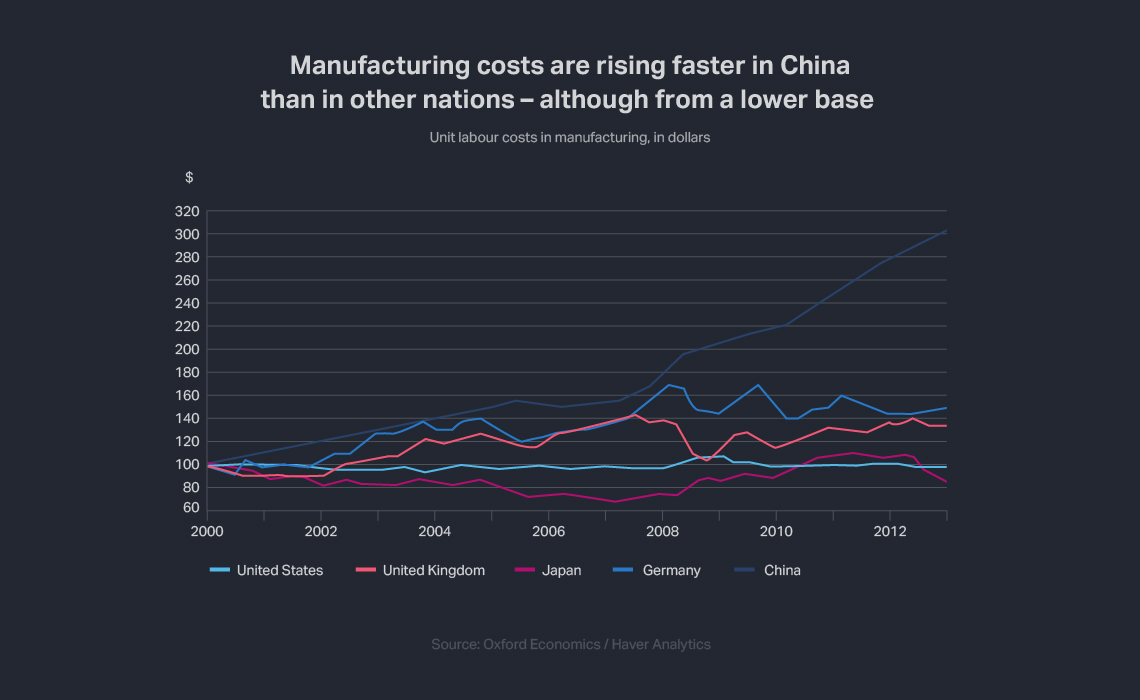
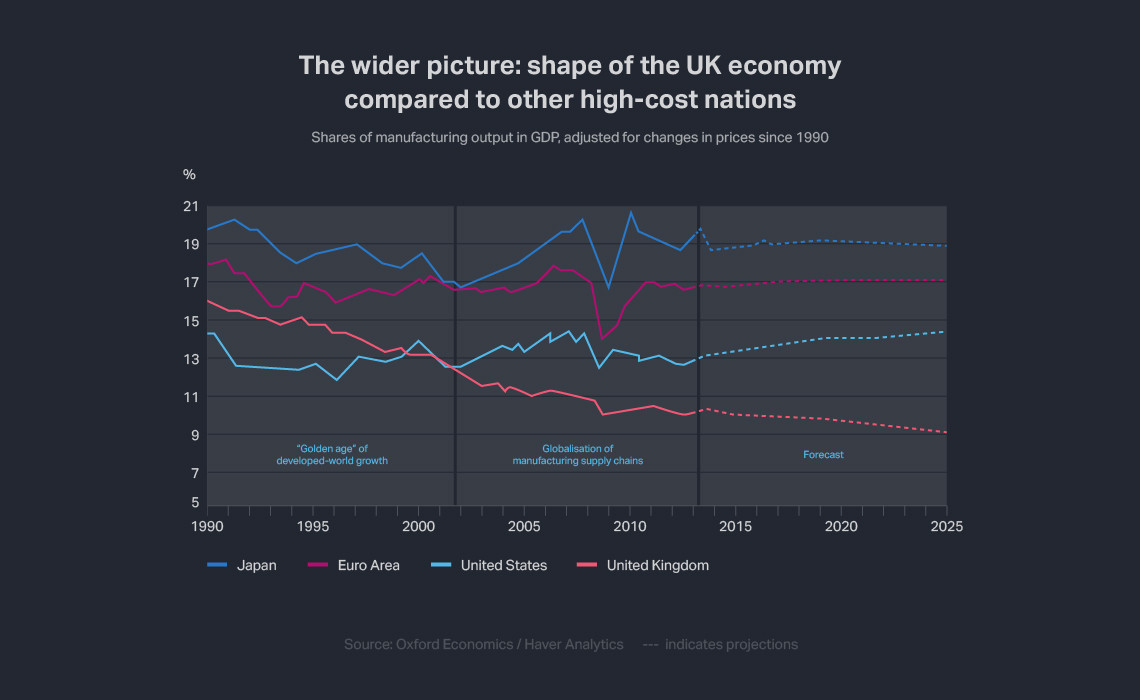
Most other industrialised countries are expected to see their
share of global manufacturing continue to fall, particularly
Japan and Germany. (The figures for these projections are
calculated on an inflation adjusted basis with output numbers
pegged to 2010 dollars.) Each of them is expected to lose a
further 1-2 percentage points of share by 2025, driven in part
by energy cost pressures, but accentuated by slow growth in
domestic markets due to stagnant or falling populations.
British manufacturing on the other hand is projected to be
fairly resilient. While it currently has the lowest share of
global manufacturing among the major developed countries
(having fallen behind France during the 1990s) it is not
expected to fall much further. From accounting for 2.1
per cent of world manufacturing output now, the country’s share
will decline by 2025 – but by less than 0.5 percentage point,
to 1.7 per cent. In comparison with the declines of the past
three decades, this is fairly minor.
Helping this trend is the UK’s strength in two key parts of
manufacturing – cars and aerospace. Since the financial crisis,
Britain has become an important platform for automotive
production destined for continental Europe, with companies such
as Germany’s BMW stepping up investments in their UK plants.
Other makers of luxury cars such as Jaguar Land Rover and
Bentley have seen higher demand for their vehicles in new
markets in Asia led by China. Furthermore, the UK has a key
role in aerospace supply chains, which is projected to be one
of the fastest-growing sectors for the next decade.
However there remain areas of concern in other sectors such as
chemicals and fabricated metal products that are expected to be
adversely affected by relatively high energy prices. An
important conclusion is that Britain needs to address its
problems in productivity – which may be rooted in relatively
low investment in high-tech machinery as well as a poorly
trained workforce hit by a shortage of top end engineering
skills – if it is to make the most of what could be a promising
period for rich-world manufacturing in the coming decade.
A version of this article
will be published as an Oxford Economics research note.
